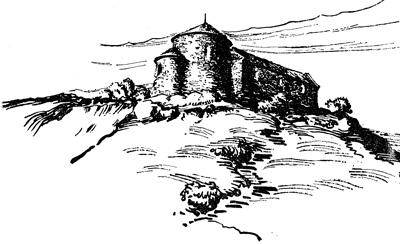© by Czesław Białczyński
© translated by Katarzyna Goliszek
One of the oldest architectural monuments in Poland is the Mound of Krak, often called the Mound of Krakus or Rękawka. The tradition tells that people who were building the mound were carrying soil in their sleeves. The issue of the etymology of the word ”Rękawka” is interesting. It may originate from the Czech word ”rakew” which means a coffin of from the Serbian ”raka” denoting a grave. The mound is the most likely to be a tumulus.
According to the tradition, it is the grave of the mythical founder of Kraków, the powerful duke of Wiślanie (Vistulans). There is no doubt that it was raised for a very important reason, with huge workload, on the highest elevation of Krzemionki – the Mount of Lasota. The material from which the mound was being raised does not come from the nearest area. Sand and gravel were carried onto the mount from the Vistula Valley.
It is known that formerly there used to be more similar mounds in Kraków. Unfortunately, those monuments have not remained till today. They were thoughtlessly destroyed. For example, the mound of Esterka in Łobzów had still existed till 1950! It was destroyed without any agreement with archaeologists while building a sports field… Or the mound on the Wawel Hill (probably it had existed up to the 18th century). Apart from Krak and Wanda, two other members of this kin had their mounds. Not too long ago because in the 19th century there was a little mound close to the mound of Krakus, called the ”Grave of Krak’s grandmother”. Not far from Kraków, in Krakuszowice (near Bochnia) is the mound of the ”Son of king Krak” to this day.
Quite close to the mound of Krak is a tiny Romance St Benedict church. There is a legend assigned to this church. The legend is about the ”Evil Princess”. Remains of an older building and the former pallatium were found in the vicinity of the church. The St Benedict church stands in the place where the pagan little god Świst (called Poświst as well) was worshipped the other day. The church is opened once a year, on Tuesday after Easter when the ritual called ”Rękawka” is held there. Initially, this folk entertainment took place at the mound of Krak. Once, the ritual reminded of a funeral wake along with the pagan holiday of Spring and the custom of worshipping of dead ancestors when people burned fires and ate. Today ”Rękawka” is a church fair related with St Benedict, the patron of the church. It is not hard to guess that this Christian custom was introduced as the replacement of the former pagan tradition.
The Rotunda-pallatium on the mount of St Benedict – reconstruction according to professor Dr Wiktor Zin
Before the Second World War the mound was partly examined. The grave of Krak was not found. Nor were the expected treasures found. It turned out that the top of the mound was violated many times. A huge, 300-year old oak grew on it once. The oak was 33 metres high and 12,5 metres wide. Obviously the mound was a place of pagans’ worship and the oak was regarded as holy. The oak was probably cut down while Christianity was developing between the 9th and 10th centuries. Digging up the mound, the explorers came across remains of a wooden post and wicker partitions. It means that the construction was made soundly, in accordance with a deeply thought over plan. During the excavations, plenty of silicon products, ceramic chips, coins (brought most probably with the soil while raising the mound) were found. And in the lower parts of the mound a brown Avar decoration most likely dating from the 8th century BC was found. This artefact was used during the estimation of the age of the mound. It was also the period of time when the oak was likely to be planted on the top of the mound – so the 7th or 8th centuries AD. The results of the age study also relate to the twin mound of Wanda that has not been studied so far (archaeologists have learned only about the whereabouts of the mound).
The Avar decoration found during archaeological studies of the mound.
Imagination is stimulated by the fact that such mounds are all along the Vistula River from Kraków to Sandomierz. They might have been tumuluses, places of the worship of pagans or they also could have made up a ”signifying” network in the state of Vistulans. The mounds must have been the observation point.
There is also a hypothesis of a Celtic origin of the mounds of Krak and Wanda which may have been helpful with marking of the seasons of the year and the most important worship holidays.
I have recently found the information that the mounds may have been used as astronomical-geodetic signs. The Sunset against the mound of Wanda can be observed from the mound of Krakus on 2nd May and 10th August whereas the West is seen above the mound of Krakus on 4th November and 6th February (information from: http://www.fortyck.pl/wiesci_inne_54.htm).
The two mounds: of Krak and of Wanda make up an equilateral triangle with the Wawel Hill (on which the mound once existed)! This lets us suppose that our ancestors raised the mounds with full awareness and that their role was significant once.
Bibliography:
„Kopce na ziemiach Polski” (”Mounds on the territory of Poland”) by G. Gill
Tagged with: Jerzmanowice, Kopiec Wawelski (The Wawel Mound), Skała Syriusza (The Rock of Syrius), Wawel centrum ziemskiego Zodiaku (Wawel the centre of the Earth Zodiac), Zodiak i jego odzwierciedlenie w Krakowie (Zodiac and its image in Kraków), Zodiak i Kopce krakowskie (Zodiac and mounds of Kraków)


